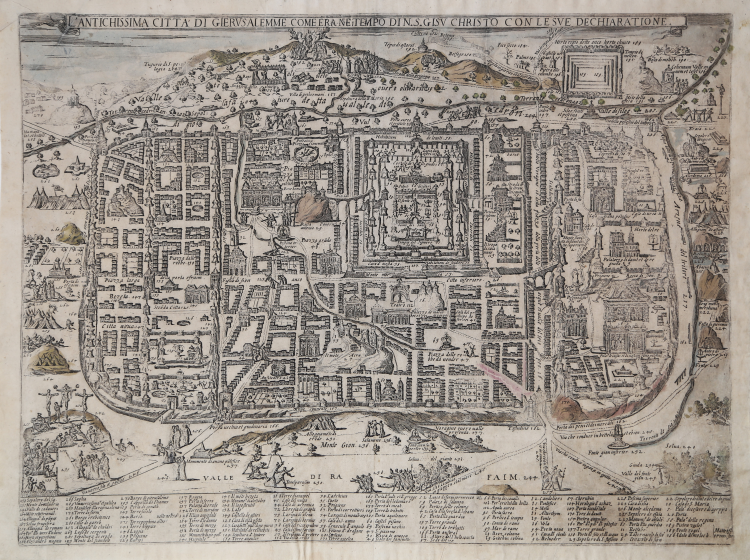



| Reference: | S35101 |
| Author | Matteo FLORIMI |
| Year: | 1600 ca. |
| Zone: | Jerusalem |
| Measures: | 510 x 380 mm |


| Reference: | S35101 |
| Author | Matteo FLORIMI |
| Year: | 1600 ca. |
| Zone: | Jerusalem |
| Measures: | 510 x 380 mm |
At the top, in a ribbon-shaped scroll placed under the upper edge, the title is engraved: L’ANTICHISSIMA CITTA DI GIERUSALEMME COME ERA NEL TEMPO DI N.S. GISU CHRISTO CON LE SUE DECHIARATIONE. In the lower margin, arranged in fourteen columns, we find a numerical legend of 134 references (non-progressive numbering) to notable places and monuments of the city. In the last column at the bottom right you can find the editorial imprint Matteo florimi for.
It is a derivation of Christian van Adrichem's map (1584), or more probably of its Italian copy by Giacomo Franco (1590). Like these, it describes the city at the time of Christ. The map, not described by Laor, is rather rare and only a few examples have been recorded. The date of around 1595 is suggested by van der Heijden, but there are no concrete elements to support it, and a dating around 1600, more congruous with Florimi's activity, is also possible.
“Giacomo Franco's map derives from that of Christian van Adrichem, included in the work Jerusalem et suburbia eius sicut tempore Christi fluvuit, published in Cologne in 1584. According to bibliographic sources, it would be included in the rare pirated Italian version of the work, printed in Verona with the title Breve descrittione della citta’ di Gierusalemme …composta da Christiano Adricomico Delfo, et poi tradotta di latino in volgare dal Sig. Pier Francesco Toccolo veronese, edited by Marco Antonio Palazzolo in 1590. It is probable that the publisher Giacomo Franco drew free inspiration from the work of Adrichem, or that he was commissioned by the dedicatee, Marco Zano Cornaro, Veronese captain and knight” (cf. Cartografia e Topografia Italiana del XVI secolo, p. 632).
Etching and engraving, printed on contemporary laid paper without watermark, with thin margins, perfectly restored longitudinal tear, minimal abrasions, otherwise in excellent condition.
Very rare work, registered for only 5 institutional examples according Bifolco-Ronca (cf Cartografia e Topografia Italiana del XVI secolo, p. 634).
Matteo Florimi (Polistena c. 1540 - Siena 1613) was a publisher and merchant of books and prints. Of Calabrian origin, he settled in Siena in 1581, with a store “in Banchi”. Matteo Florimi's chalcographic activity was several times joined by master engravers such as Cornelis Galle, Arnoldo Arnoldi, Pieter de Iode, Jan Sadeler and artists such as Francesco Vanni, Ventura Salimbeni and Alessandro Casolani, with whom the printer collaborated in the preparation of religious subjects. Florimi's cartographic activity produced prints of many cities and territories around the world, which were never drawn for him, but were manipulations of already existing reliefs, or of maps published by other printers. In the second half of the sixteenth century, Florimi was far-sighted in devoting himself to the production of bird's-eye views of cities as faithfully as possible. Florimi copied some maps by Antonio Lafreri, Claude Duchet, Abraham Ortelius. As far as map engraving work was concerned, in 1600, Matteo Florimi called the Flemish engraver Arnoldo degli Arnoldi to work in his workshop with the promise of greater compensation than that bestowed upon him by Giovanni Antonio Magini, with whom the artist was working. This offer by Florimi triggered the wrath of Magini, who, though not naming him, called him an "envious counterfeiter" for stealing such a skilled cartographer from him. The collaboration between Florimi and Arnoldi lasted only two years (1600-1602), but it was quite productive: together they printed the Stato di Siena, la Choronografia Tusciae, la Nuova descrittione della Lombardia, l’Europa, l’America and the Descrittione Universale della Terra.
Bibliografia
Bifolco-Ronca, Cartografia e Topografia Italiana del XVI secolo (2018), tav. 205; Elisa Boffa, Un tipografo calabrese a Siena: Matteo Florimi, in “Accademia dei Rozzi” (2013): II, n. 3; H.A.M. van der Heijden, Matteo Florimi (+1613) – Landkarten und Stadtplanverleger in Siena, in “Florilegium Cartographicum”, Lipsia (1993): n. 26; Ganado (1994): p. 215, n. 84; Shirley (2004): III, n. 33; Tooley (1983): n. 343c.
Matteo FLORIMI (Polistena 1540 circa - Siena 1613)
|
Print and book dealer and publisher, from Calabria. He came to Siena c.1581.Shop in Banchi. The first evidence of his independent activity is of 1589. In 1591 he published a book of patterns for lace, The Fiori di ricami, in Venice, and in 1593 a second edition in Siena.
In 1597 he published the Life of St Catherine, engraved by De Jode after Vanni, and the Passion of Christ by De Jode after Andrea Boscoli. He published a large number of maps and figural prints are mostly religious. He employed engravers of the calibre of Agostino Carracci, Cornelis Galle, Pieter de Jode Villamena and Thomassin, among others.
He commissioned drawings from Andrea Boscoli. He had a particularly close relationship with Vanni. In the years 1605-8, Florimi received financial support from Ottavio Cinuzzi.
|
Matteo FLORIMI (Polistena 1540 circa - Siena 1613)
|
Print and book dealer and publisher, from Calabria. He came to Siena c.1581.Shop in Banchi. The first evidence of his independent activity is of 1589. In 1591 he published a book of patterns for lace, The Fiori di ricami, in Venice, and in 1593 a second edition in Siena.
In 1597 he published the Life of St Catherine, engraved by De Jode after Vanni, and the Passion of Christ by De Jode after Andrea Boscoli. He published a large number of maps and figural prints are mostly religious. He employed engravers of the calibre of Agostino Carracci, Cornelis Galle, Pieter de Jode Villamena and Thomassin, among others.
He commissioned drawings from Andrea Boscoli. He had a particularly close relationship with Vanni. In the years 1605-8, Florimi received financial support from Ottavio Cinuzzi.
|